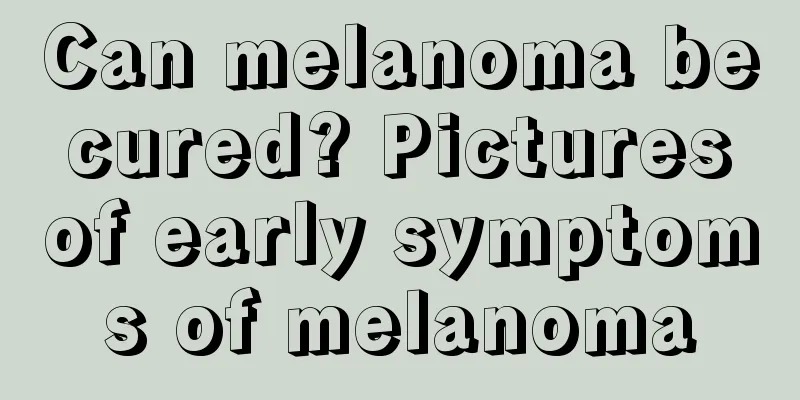Can melanoma be cured? Pictures of early symptoms of melanoma

|
Melanoma is a malignant tumor originating from melanocytes in the pigmented areas of the skin, mucous membranes, eyes and central nervous system. It is a common skin tumor caused by excessive proliferation of abnormal melanocytes. It is highly malignant and accounts for the vast majority of deaths from skin tumors. Melanoma, also known as malignant melanoma, is a highly malignant tumor that can produce melanin. It is mostly seen in adults over 30 years old. Those that occur in the skin are more common on the soles of the feet, the vulva and around the anus. It can be malignant from the beginning, but it usually develops from the malignant transformation of a junctional nevus. Any mole that becomes darker in pigment, larger in size, grows faster or ulcerates, becomes inflamed and bleeds is often a sign of malignant transformation. This tumor can also occur in mucous membranes and internal organs. The tissue structure of melanoma is diverse, and tumor cells can be arranged in nests, cords or alveoli. Tumor cells can be polygonal or spindle-shaped, with large nuclei, often with coarse eosinophilic nucleoli, and melanin granules in the cytoplasm. There are also melanomas without melanin granules in the cytoplasm, which are called amelanotic melanomas, but the DOPA reaction may be positive. Under the electron microscope, it can be seen that there are a few typical melanosomes or pre-melanosomes in the cytoplasm, which is helpful for diagnosis. The prognosis of melanoma is mostly poor, and lymphatic and blood metastasis may occur in the late stage. Therefore, early diagnosis and timely treatment of this tumor are very important. Clinically, melanoma is extremely malignant. Most melanomas occur on the basis of pigment lesions, and a few occur in pigment cells of normal skin or mucous membranes. If there are melanin spots or moles on the scalp at the site of the lesion, due to repeated stimulation from haircuts, shampooing, itching, or long-term pressure and friction from wearing a hat, the epidermis will erode, the attached hair will fall off, and it will gradually increase in size and become a tumor. 1. Classification by morphology (1) Nodular melanoma: The lesion is nodular and higher than the skin surface. The color is mostly black, but can also be brown, blue-black, grayish white and light red. It is surrounded by a red halo and has a smooth surface. It is polyp-like or cauliflower-like. It develops rapidly and can rupture on its own and bleed. This type of melanoma metastasizes very early, with early warning regional lymph node enlargement, and often metastasizes to organs such as the lungs, brain, and liver. For those who receive treatment before metastasis, the 5-year survival rate is 50% to 60%. (2) Superficial melanoma: also known as eczematoid cancer, it grows slowly and metastasizes later. The 5-year survival rate is 70%. 2. Clinical staging The stage of the disease is estimated based on the range of the primary lesion, the status of lymph node metastasis, and whether there is distant metastasis in imaging examinations. (1) Stage I: no regional lymph node metastasis. (2) Stage II: with regional lymph node metastasis. (3) Stage III: with distant metastasis. Traditional Chinese medicine believes that malignant melanoma occurs when wind evil attacks blood and qi, causing changes; or blood in the veins stagnates in the Wei division, causing the yang qi to be bound; turbid qi in the kidney mixes with yang, causing the yang qi to be bound, and is related to factors such as blood coagulation and qi stagnation. The real reason for normal melanocytes to become tumorous is still unclear, but it may be related to the following factors: (1) Air pollution. The large-scale emission of harmful substances such as Freon destroys the ozone layer, resulting in insufficient ultraviolet filtration. Harmful ultraviolet rays and harmful substances in the air work together to act on human skin, causing abnormal expression of melanocytes and triggering melanoma. (2) The desire for beauty is at work. In order to pursue clean and tender skin, many people use a large amount of chemical cosmetics, causing chemical skin pollution. Some people even use chemical corrosives to remove moles on the skin, but the result is counterproductive and stimulates excessive proliferation of melanocytes. (3) Lack of health knowledge. Moles growing on the feet, perineum and other parts that are prone to friction are not given enough attention. Due to long-term squeezing and friction, they eventually undergo malignant transformation. (4) Abuse of estrogen drugs. Studies have found that there are estrogen receptors in the cells of malignant melanoma. Therefore, people suspect that excessive estrogen will stimulate the occurrence of melanoma. (5) Immune defects. With the improvement of living standards, the life expectancy of Chinese people has been significantly extended. With the increase of age, the human immune function gradually declines. Studies have found that low immune function is one of the important causes of melanoma, so the clinical incidence of melanoma in the elderly is very high. (6). Benign melanin plaques are moles, among which junctional moles are most likely to become malignant, mixed moles are less likely, and endothelial moles rarely become malignant. However, most scalp melanomas are not transformed from moles, so some people believe that this disease is not entirely related to moles. (7). Race. Whites have a higher incidence rate than people of color. For example, the annual incidence rate of white Americans is as high as 42/100,000, while that of blacks is only 0.8/100,000. In daily life, try to avoid sun exposure. Using a sunshade is an important primary prevention measure for melanoma, especially for those high-risk groups. Strengthen education for the general public and professionals to improve the three earlys, namely early detection, early diagnosis, and early treatment. For pigmented nevi that occur in areas prone to friction, biopsy should be performed for pathological examination. For example, a large hairy nevus on a child's waist is often rubbed and squeezed by the belt. It should be completely removed as soon as possible. If it is difficult to remove all at once, the main part can be removed as much as possible in the middle of the large hairy nevus before it becomes malignant, and the two sides can be sutured. After the surrounding skin is loosened, the remaining part can be removed until the nevus is completely removed to prevent malignant transformation. Each specimen removed must be sent for pathological examination. If there is malignant transformation, it should be completely removed and skin grafting should be performed. It is not advisable to stimulate moles with corrosive drugs or thorough freezing. It is dangerous if the moles cannot be frozen off in one time and are repeatedly frozen off several times, because moles often become malignant due to traumatic stimulation. It is reported that some people have become malignant due to incomplete freezing. About 30% to 50% of malignant melanomas are related to external stimulation. If it is necessary for cosmetic purposes, the mole should be removed at one time, which is safer and more reliable. Freezing should be combined with excision, and it should be completed in one time. Avoid excision in multiple times. The excised specimen should be sent for pathological examination. I. Western medicine treatment (I) Surgical treatment 1. Biopsy surgery: For patients suspected of malignant melanoma, the lesion should be removed together with the surrounding 0.5cm to 1cm normal skin and subcutaneous fat for pathological examination. If it is confirmed to be malignant melanoma, the depth of infiltration will determine whether additional extensive excision is needed. Generally, incisional or forceps biopsy is not performed unless the lesion has ulcerated or the lesion is too large and one-time excision will cause disfigurement or disability and must be confirmed by pathology first. However, the incisional biopsy must be connected with radical surgery as close as possible. In a prospective analysis, the World Health Organization Collaborative Center for Diagnosis and Treatment Evaluation of Malignant Melanoma believes that excisional biopsy not only has no adverse effect on prognosis, but also can understand the depth and range of infiltration of the lesion through biopsy, which is conducive to formulating a more reasonable and appropriate surgical plan. 2. Excision range of primary lesion: The old view that 5 cm of normal skin must be included when excising the lesion has been abandoned. Most oncologists only remove 1 cm of normal skin outside the tumor edge for thin lesions with a thickness of ≤1 mm. For lesions with a thickness of more than 1 mm, wide excision should be performed 3 cm to 5 cm away from the tumor edge. Malignant melanoma located at the extremities often requires finger (toe) amputation. 3. Regional lymph node dissection (1) Indications: Most oncologists in the United States hold the following treatment attitudes: ① For lesions with a thickness of ≤1 mm, the metastasis rate is very low, and preventive lymph node dissection cannot be expected to change the long-term prognosis; ② For lesions with a thickness of >3.5 cm to 4 mm, the possibility of occult distant metastasis is high, and the long-term survival rate is relatively low (20% to 30%). Even if preventive lymph node dissection is performed, it is difficult to expect a significant improvement in survival rate. Despite this, there are many people who advocate that preventive lymph node dissection should be performed as long as there are no distant metastatic lesions that can be found; ③ For lesions with a thickness between the above two categories, the occult lymph node metastasis rate is quite high, and preventive lymph node dissection is the best candidate for improving survival. (2) Scope of regional lymph node clearance: When performing cervical lymph node clearance for malignant melanoma of the head and neck, if the primary lesion is located on the face, the lymph nodes in the parotid area, submental area and submandibular triangle should be cleared; if the lesion is located in the occipital region, the lymph nodes in the posterior cervical triangle should be cleared. Malignant melanoma occurring in the upper limbs requires axillary lymph node clearance, and if it occurs in the lower limbs, inguinal or iliac inguinal lymph node clearance should be performed. Malignant melanoma occurring in the chest and abdomen should undergo ipsilateral axillary or inguinal lymph node clearance, respectively. 4. Palliative resection: For patients with large lesions and distant metastases who are not suitable for radical surgery, debulking or palliative resection can be considered to relieve ulcer bleeding or pain as long as the anatomical conditions permit. (II) Radiotherapy: Except for some very early freckle-type malignant melanomas, which are effective for radiotherapy, other primary lesions are generally not effective. Therefore, radiotherapy is generally not used for primary lesions, but for metastatic lesions. At present, the commonly used radiation dose is: for superficial lymph nodes, soft tissues and metastatic lesions in the chest, abdomen and pelvis, the irradiation dose is ≥500 cCy each time, twice a week, with a total of 2000-4000 cCy; for bone metastases, the irradiation dose is 200-400 cCy each time, with a total of more than 3000 cCy. (III) Chemotherapy 1. Single drug (1) Nitrosourea drugs: They have a certain effect on melanoma. According to comprehensive literature reports, BCNU treated 122 cases of melanoma with an effective rate of 18%, MeCCNU treated 108 cases with an effective rate of 17%, and CCNU treated 133 cases with an effective rate of 13%. (2) Decarboxylamine (DTIC): The emergence of DTIC has made a step forward in the treatment of melanoma and has become the most widely used drug. GaiLanl reported that DTIC had the best effect. It treated 28 cases of melanoma with a dose of 350 mg/m2 each time, for 6 consecutive days, with a course of 28 days, and an effective rate of 35%. 2. Combination therapy: Malignant melanoma is not very sensitive to chemotherapy, but combination therapy can improve the efficacy and reduce toxic reactions. Commonly used combination chemotherapy regimens are as follows: (1) DAV regimen (DTIc, ACNu, VCR) is the preferred chemotherapy regimen for melanoma. Dosage: DTIcloo~200mg, ivd1~5ACNUl00mgivd1VCR2mgivd1, repeated once every 21 days. (2) DDBT regimen (DTIC, DDP, BCNU, TAM) Usage: DTIC220mg/m2, intravenous injection d1~3/3w, DDP25mg/m2, intravenous drip d1~3w, BCNUl50mg/m2, intravenous injection d1/6w, TAM10mgPO, 2/d. The efficacy is 52.5%. (3) CBD regimen (CCNU, BLM, DDP) Usage: CCNU 80mg/m2, oral, d1/6w, BLM 15u/m2, intravenous injection d3-7/6w, DDP 40mg/m2, intravenous injection d8/6w. The effective rate is 48%. (IV) Immunotherapy The spontaneous regression of malignant melanoma indicates that it is related to the body's immune function. Bacillus Calmette-Guérin (BCG) can make the lymphocytes in the body of melanoma patients concentrate on tumor nodules, stimulate the patient to produce a strong immune response, and achieve the effect of treating tumors. BCG can be used by skin scratching, intratumoral injection and oral administration. For local small lesions, BCG is used for intratumoral injection, and the effective rate can reach 75% to 90%. In recent years, biological response modifiers such as interferon, interleukin-2 (ILA-2) and lymphokine-activated killer cells (LAK cells) have been tried and achieved certain results. Prognosis The recurrence and metastasis rates of melanoma are both high, and the prognosis is poor. Factors that affect prognosis include: 1. It is related to the depth of tumor infiltration. According to the results of a follow-up of a group of malignant melanoma by the World Health Organization, the prognosis is closely related to the thickness of the tumor. For patients with tumors ≤0.75mm, the 5-year survival rate is 89%, and for patients ≥4mm, it is only 25%. 2. Lymph node metastasis. The 5-year survival rate of patients without lymph node metastasis is 77%, while that of patients with lymph node metastasis is only 31%. The survival rate is also related to the number of lymph node metastases. 3. Lesion site. The site of malignant melanoma is related to prognosis. Those occurring in the trunk have the worst prognosis, with a 5-year survival rate of 41%; those located in the head are second, with a 5-year survival rate of 53%; those in the limbs are better, with a 5-year survival rate of 57% in the lower limbs and 60% in the upper limbs; melanoma occurring in the mucosa has a worse prognosis. 4. Age and gender. It is generally believed that female patients are significantly better than male patients, and younger patients are better than older patients. 5. The surgical method is related to the thickness of the tumor and the range of resection. For a thickness of ≤0.75mm, the resection range is 2 to 3cm from the edge of the tumor; for a thickness of >4mm, the wide resection is within 5cm from the edge of the tumor. Regional lymph node dissection that does not meet the specifications often promotes the spread of the tumor to the whole body and affects the prognosis. 2. TCM treatment of malignant melanoma is a disease of deficiency and excess. Judging from the clinical manifestations of many patients, the syndrome differentiation and treatment of malignant melanoma should focus on the following syndrome types for syndrome differentiation and treatment. 1. Qi stagnation and blood stasis syndrome: The lump is black, or even painful, accompanied by depression and discomfort, or distending pain, or skin and nail disorder, dark red tongue, thin white tongue coating; or there are ecchymoses and petechiae on the edge and tip of the tongue, and the veins of the tongue are distended; or the tongue is light red at first, but turns purple and dark within 4 to 5 seconds. The pulse is thin and astringent, or stringy and thin. Treatment method: activate blood circulation and qi, remove blood stasis and dredge the collaterals. Prescription: Taohong Siwu Decoction with added ingredients: Angelica, Red Peony Root, Chuanxiong, Panax Notoginseng, Pangolin, Clematis, Salvia Miltiorrhiza, Peach Kernel, Safflower, Leech, Earthworm, Rehmannia Glutinosa, Cyperus Rhizoma, Tangerine Peel. 2. Symptoms of severe stasis and toxicity: The lumps are black, or red, or ulcerated and oozing pus and blood, or scattered, oozing dirty yellow water, pain, accompanied by restlessness and insomnia, dry mouth and bitter mouth, dry and hard stools, yellow and red urine, red tongue, or even crimson, yellow and dry tongue coating, and stringy and slippery pulse. Treatment: Clear away heat and detoxify, activate blood circulation and remove blood stasis. Prescription: Wuwei Xiaodu Yin combined with Xihuang Wan with modified ingredients: Honeysuckle, Taraxacum, Di Ding, Wild Chrysanthemum, Purple-backed Gynura, Coptis chinensis, Gardenia, Bezoar, Processed Frankincense, Processed Myrrh, Raw Rhubarb, Musk. 3. Qi and blood deficiency symptoms: after surgical resection of malignant melanoma, or primary tumor resection but metastatic lesions still exist, or without surgical resection, there is no local pain, the tumor has not ulcerated, but there is fatigue, pale complexion, shortness of breath when moving, palpitations, pale tongue with tooth marks on the edges, thin white fur, weak or intermittent pulse. Treatment: replenish qi and nourish blood, detoxify and remove blood stasis. Prescription: Bazhen Decoction with modifications. Codonopsis pilosula 20g, Cangbaizhu 20g each, Poria 30g, Licorice 20g, Rehmannia glutinosa 20g, Angelica 20g, Red Peony 20g, Chuanxiong 10g, Astragalus 30g, Moss Bark 30g, Sophora flavescens 10g, Herba Cynanchum 10g, Herba Hedyotis diffusae 30g, Daihesan 20g. Analysis: This syndrome is more common in the elderly or those with long-term illness, so Bazhen Decoction plus Huangqi is used to nourish qi and blood to strengthen the body, and white moss peel, Sophora flavescens, Caoheche, Hedyotis diffusa, and Daihe powder are used to detoxify and remove blood stasis to attack the evil. 4. Main symptoms of spleen and kidney yang deficiency: rupture of melanoma, thin and clear fluid, fatigue, bland taste, low appetite, preference for warm food, stomach bloating after eating cold food, cold body and cold limbs, loose stools and clear urine, fat tongue with light or light purple color, tooth marks on the sides of the tongue, white and greasy fur, deep and weak pulse. Treatment: tonify the kidney and spleen, strengthen the body and suppress cancer. Prescription: Add flavor to Sijunzi Decoction. Codonopsis pilosula 15g, Atractylodes macrocephala 10g, Poria 15g, Licorice 6g, Astragalus 10g, Epimedium 10g, Cornus officinalis 15g, Morinda officinalis 10g, Safflower 10g, Psoralea corylifolia 10g. Analysis: This prescription uses Four Gentlemen and Astragalus to strengthen the spleen and replenish Qi to support the acquired foundation, and uses Epimedium, Cornus officinalis, Morinda officinalis, Safflower, and Psoralea corylifolia to warm and replenish kidney yang to save the acquired foundation. This prescription is suitable for patients with advanced malignant melanoma. 1) Melanoma patients often eat nutritious dried fruit and seed foods, such as sunflower seeds, sesame seeds, pumpkin seeds, peanuts, raisins, etc. These foods contain multiple vitamins, minerals, cellulose, protein, and unsaturated fatty acids. This is also one of the dietary taboos for melanoma. 2) Melanoma patients should eat more fresh fruits and vegetables, which contain a large amount of vitamin A, vitamin C, vitamin E, etc. In recent years, studies have found that they have antioxidant effects, can remove free radicals, block the synthesis of carcinogen nitrosamines, inhibit the degeneration of squamous epithelial cells and the occurrence of cancer cells, and also have the effects of enhancing the body's immune function and promoting ulcer healing. 3) Melanoma patients often eat foods that contain anti-carcinogenic effects, such as kohlrabi, cabbage, shepherd's purse, etc. 1. Eat less fat. Although fat is the main source of calories for the human body, it should not be consumed excessively. Long-term high-fat diets can easily lead to melanoma, colorectal cancer, and breast cancer. In addition, cancer patients often experience nausea, vomiting, aversion to greasy food, and poor digestive function during treatment or disease progression, so they should adopt a low-fat diet. 2. Protein intake should not be excessive, but a diversified diet should be adopted. Because cancer patients often cause digestive tract reactions during radiotherapy and chemotherapy, which leads to weakened digestive function, or tumors increase body consumption and cause malnutrition, or even cachexia, many people blindly adopt high-protein diets. Little do they know that high-protein diets will increase the burden on the gastrointestinal tract, weaken the gastrointestinal digestion and absorption function, and are not conducive to the treatment of tumors. Many experiments have shown that high-protein diets are positively correlated with the incidence of ovarian cancer and prostate cancer. 3. Do not eat salted and smoked foods; do not consume too many cold drinks and cold foods. |
<<: What are the causes of liver cancer? How can we prevent liver cancer?
Recommend
There are 7 ways to moisturize dry and flaky skin
When it comes to the topic of dry and flaky skin,...
Does advanced lung cancer still require surgery?
Once such changes occur in the late stage, our su...
Damage to the eye nerve
Eyes are the windows to the soul and the vehicle ...
What happens if you don't eat during your period
Menstruation is the main time for weight loss. I ...
Which hospital is good for prostate cancer
Which hospital is good for prostate cancer? This ...
The harm of long sleep time
After a busy day or during holidays, many people ...
How to maintain dentures
We all know that once there is a problem with the...
What are the benefits of boiling yellow peel leaves in water for bathing
I believe everyone has heard about using kumquat ...
Chemotherapy first, then surgery?
Malignant tumors are very common diseases in norm...
What to do if arm muscle is strained, relief method is crucial
Arm muscle strains are very common in some activi...
The best way to prevent testicular cancer
Many of us have heard of testicular cancer. It is...
Can anemia be improved through blood transfusion?
Anemia is a very common disease in daily life. It...
Lung cancer obstructive pneumonia
Obstructive pneumonia can be caused by lung cance...
Indications of Cyclic Adenosine Glucoamine for Injection
Cycloadenosine meglumine for injection is used as...
What is the method of cervical scraping
We all know that scraping has many benefits to ou...









